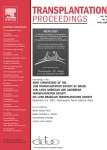Control of Cryopreservation procedures on blood vessels using fiber X-Ray Diffraction
Dublin Core
Título
Tema
Abstract
We sought to determine variations in fiber organization at the molecular level using x-ray diffraction analyses on human blood vessel specimens after cryopreservation processes.
Materials and Methods
Diffractometric profiles were performed on aortic and carotid cryopreserved-thawed vessel samples (CVS) versus the same fresh vessel samples (FVS). X-ray diffraction was performed on vascular tissues from 17 cadaveric donors after informed consent. Measurements utilized a Seifert Scintag PAD-II powder diffractometer with CuKa radiation; λ = 1.5418 Å. Scans were evaluated in the 5° to 60° range in theta −2theta mode, in the 5° to 60° range in 2-theta, with steps 0.1° and 10 seconds per step. Ten aortic and 8 carotid diffractometric profiles were analyzed, using differential planimetric surfaces measured under x-ray diffraction curve. Diffractographic profiles were analyzed according to intervals based upon the ages of the donors. An ordering profile coefficient (OPC) was obtained as the quotient between the differential planimetric surface (DPS) of FVS versus CVS vessel ordering diffraction.
Results
There was a decreased ordering profile according to age: older donors showed less ordering than younger ones. Clear peaks at d-spacing of 2.86 Å and 2.15 Å (2-theta = 31.3° and 42.0°, respectively) were always confirmed despite the different profiles of samples. OPC showed a higher ordering profile among the CVS than FVS: 70% aortas and 62.5% carotids.
Conclusion
The cryopreserved-thawed procedure does not damage the fibrillar organization of vessels.
Autor
Fuente
Editor
Fecha
Derechos
Información sobre Derechos de Autor
(Por favor lea este aviso antes de abrir los documentos u objetos)
La legislación uruguaya protege el derecho de autor sobre toda creación literaria, científica o artística, tanto en lo que tiene que ver con sus derechos morales, como en lo referente a los derechos patrimoniales con sujeción a lo establecido por el derecho común y las siguientes leyes
(LEY 9.739 DE 17 DE DICIEMBRE DE 1937 SOBRE PROPIEDAD LITERARIA Y ARTISTICA CON LAS MODIFICACIONES INTRODUCIDAS POR LA LEY DE DERECHO DE AUTOR Y DERECHOS CONEXOS No. 17.616 DE 10 DE ENERO DE 2003, LEY 17.805 DE 26 DE AGOSTO DE 2004, LEY 18.046 DE 24 DE OCTUBRE DE 2006 LEY 18.046 DE 24 DE OCTUBRE DE 2006)
ADVERTENCIA - La consulta de este documento queda condicionada a la aceptación de las siguientes condiciones de uso: Este documento es únicamente para usos privados enmarcados en actividades de investigación y docencia. No se autoriza su reproducción con fines de lucro. Esta reserva de derechos afecta tanto los datos del documento como a sus contenidos. En la utilización o cita de partes debe indicarse el nombre de la persona autora.
Formato
Idioma
Tipo
Identificador
- Fecha de agregación
- November 4, 2014
- Colección
- Bibliografía Nacional Química
- Tipo de Elemento
- Document
- Etiquetas
- Rayos X, Sangre
- Citación
- Perez Campos, H., “Control of Cryopreservation procedures on blood vessels using fiber X-Ray Diffraction,” RIQUIM - Repositorio Institucional de la Facultad de Química - UdelaR, accessed July 26, 2024, https://riquim.fq.edu.uy/items/show/2003.
- Archivos

